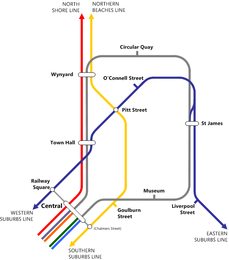City Circle
| City Circle | |
|---|---|
|
View across Circular Quay, the halfway point of the city circle line. | |
| Overview | |
| Termini | Central |
| Stations | 6 |
| Services |
T2 Airport, Inner West & South Line T3 Bankstown Line |
| Operation | |
| Opened | 20 January 1956 |
| Owner | RailCorp |
| Operator(s) | Sydney Trains |
| Depot(s) | Eveleigh |
| Rolling stock | S, K, C, M & A sets |
| Technical | |
| Track length | 6km |
| Track gauge | 1,435 mm (4 ft 8 1⁄2 in) standard gauge |
The City Circle is a system of largely underground passenger railway lines located in the central business district of Sydney, Australia, that make up the heart of the Sydney passenger railway network. The lines are owned by RailCorp, a government agency of the state of New South Wales, and operated under Transport for NSW's Sydney Trains brand. Despite its name, the City Circle is of a horseshoe shape, with trains operating in a U-shaped pattern. The constituent stations of the Circle are (clockwise): Central, Town Hall, Wynyard, Circular Quay, St James, Museum and back to Central.
History and description
.jpg)


The original concept for the City Railway was part of a report dated 1915 submitted to the government by John Bradfield upon his return from overseas study,[1] with work commencing the following year. His concepts were largely based on the New York Subway, which he observed during his time in New York City.
The City Circle was built in stages. The first stations to open were Museum and St. James, which opened in 1926 as part of the initial electrification of Sydney railways. Next was the "western limb" through Town Hall and Wynyard, which opened in 1932 in conjunction with the opening of the Sydney Harbour Bridge. This section contains four tunnels. Two connected to the Harbour Bridge, while the two City Circle tunnels terminated at Wynyard. In 1956 the dead ends at St. James and Wynyard were joined and the "missing link", Circular Quay – was opened. Central and Circular Quay are above-ground stations (Circular Quay is elevated, directly underneath the Cahill Expressway), while the remainder are below ground. Several unused railway tunnels also exist. The former tram tunnels at Wynyard, and other stub tunnels at St James are well known.
Services and operations
Current service patterns generally consist of trains from the South and Inner West lines operating around the City Circle in a clockwise manner via Town Hall station and proceed onto the Airport & East Hills, and Bankstown lines. This track is known as the "City Outer". Trains from the Airport & East Hills and Bankstown lines generally operate around the City Circle in an anti-clockwise manner via Museum station and proceed onto the South and Inner West lines (using the "City Inner" track). A set of flying junctions at Central enable this pattern to be varied.
Prior to the integration of the Eastern Suburbs line into the Illawarra Line in 1980, Illawarra line trains also operated around the City Circle.
Trains on the Western and Northern lines usually do not proceed around the City Circle but instead proceed across the Harbour Bridge to the North Shore line and vice versa. During weekend trackwork, trains from the City Circle may go to Penrith/Richmond, Cronulla/Waterfall or Epping/Hornsby via Strathfield.
In 2005, when CityRail completed its most recent estimate of station boardings, the City Circle accounted for 221,160 weekday entries and exits, equivalent to over 55 million annual trips.[2]
It operates a service every 3 to 5 minutes during peak hours, 6 minutes at other times and 8 to 10 minutes on weekends.
Gallery
-

Platform 18 and 19 at Central station
-
Town Hall – platform 4 (Illawarra line platform)
-

Wynyard station entrance, Department of Railways building, York Street
-

Circular Quay station
-
St James platform 1
-

Museum platforms
References
- ↑ 50 Years – A Long Time Wylie, R.F. Australian Railway Historical Society Bulletin, June 1971 pp140-143
- ↑ Region 9 Ministry of Transport Retrieved 2008-08-06
External links
- Sydney Trains Network site
- NSW rail City Circle